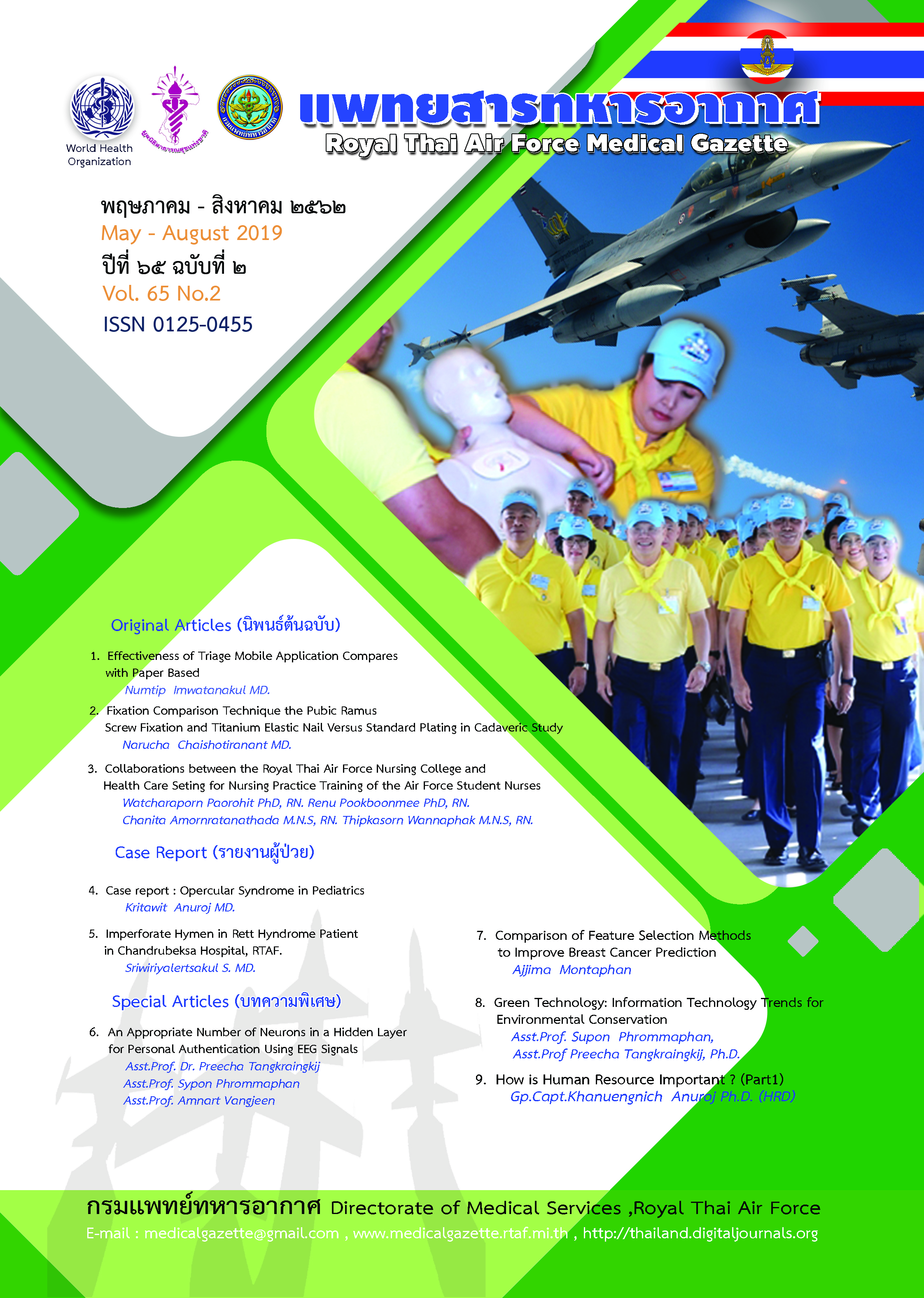Effectiveness of Triage Mobile Application Compares with Paper Based
Main Article Content
Abstract
Objective : To evaluate the BAHT mobile application in terms of accuracy and inter-rater reliability
compared with the original paper form.
Material and method : Descriptive study. The population of the study was patients who presented to the emergency room, Bhumibol Adulyadej Hospital during 1 September to 31 October 2018. The patients were evaluated by triage nurses and emergency medical residents in a simple random sampling used the BAHT mobile application or the original paper form. The gold standard was determined by three professional emergency physicians based on Bhumibol Adulyadej Hospital triage handbook 2018. The Kappa statistic indicated the level of agreement between two categorical assessments and the Chi-square test indicated the accuracy.
Results : Over two months, 480 ED patients were assessed; 459 (96 %) completed data were available.
The Kappa statistics in the original paper form was 0.34 (95 %CI 0.28-0.40) P-value < 0.0001 and the BAHT mobile application was 0.88 (95 %CI 0.84-0.92) P-value < 0.0001. The percentage of accuracy in the original paper form was 71.37 % in the resident group and 81.06 % in the nurse triage group. In the BAHT mobile application, the percentage of accuracy in the resident group was 90.95 % and in the triage nurse group was 92.24 %.
Conclusion : The BAHT mobile application had significantly more effective than the original paper form in terms of accuracy and inter-rater reliability and the users had a confident and satisfaction to BAHT mobile application.
Article Details
บทความที่ได้รับการตีพิมพฺเป็นลิขสิทธิ์ของวารสาร
References
Available at: https://www.ahrq.gov/sites/default/ files/publications/files/ptflowguide.pdf.
Retrieved April 17, 2018.
2. Fry, M, Bucknall, T.K. Review of the triage literature: Past, present, future? Aust Emerg Nurs
J 2002; 5(2): 33-8.
3. National Institute of Emergency Medicine. Guidelines to follow the rules, criteria and
procedures to sort and prioritize emergency care at the emergency room, according to the
Emergency Medical Board. 3rd ed. Nonthaburi. 2015.
4. Christ M, Grossmann F, Winter D, Binggisser R, Platz E. Modern Triage in the Emergency
Department. Dtsch Arztebl Int 2010;107(50): 892-98.
5. Sandy L. Dong, Michael J. Bullard, David P. Meurer, Ian Colman, Sandra Blitz, Brian R.
Holroyd et al. Emergency triage: comparing a novel computer triage program with standard
triage. Acad Emerg Med 2005;12:502–7.
6. Timothy F. Platts-Mills, Debbie Travers, Kevin Biese, Brenda McCall, Steve Kizer, Michael
LaMantia et al. Accuracy of the Emergency Severity Index triage instrument for identifying
elder emergency department patients receiving an immediate life-saving intervention. Acad
Emerg Med 2010;17(3):238–43.
7. Karin Jordi, Florian Grossmann, Gary M. Gaddis, Eva Cignacco, Kris Denhaerynck, Ren?
Schwendimann et al. Nurses’ accuracy and self-perceived ability using the Emergency
Severity Index triage tool: a cross-sectional study in four Swiss hospitals. Scandinavian Journal of
Trauma, Resuscitation and Emergency Medicine 2015;23:62.
8. Sorravit Savatmongkorngul, Chaiyaporn Yuksen, Chanakarn Suwattanasilp, Kittisak Sawanya-
wisuth, Yuwares Sittichanbuncha. Is a mobile emergency severity index (ESI) triage better than
the paper ESI? Intern Emerg Med 2017;12: 1273–7.
9. William K. Holstein, Alphonse Chapanis. Human-factors engineering. Available at:
https://www.britannica.com/topic/human-factors-engineering. Retrieved April 29, 2018.


